
January has seen many custom R9 290 and R9 290X solutions hit retail. Following on from our Sapphire R9 290 Tri-X OC review, today we look at the latest Gigabyte R9 290 Windforce OC, which ships pre overclocked and equipped with a custom cooler. If you have a budget around £370 should this solution be making your final shortlist?

The Gigabyte R9 290 WindForce OC features a custom 3 fan cooler, versions of which we have reviewed on other Gigabyte cards in the past. The R9 270X Windforce OC which we reviewed in December 2013 for instance, was an extremely impressive video card.
Gigabyte have overclocked their R9 290 Windforce from reference speeds of 947mhz to 1,040mhz although they have left the GDDR5 memory speeds at 1,250mhz (5Gbps effective). Let us take a look at the card, before putting it through our tests.

We received our sample straight from Gigabyte HQ in the Far East. It shipped in a full retail box, but is missing the accessories.


Gigabyte's Windforce cooler looks great, with three large fans spanning the full width of the PCB. Gigabyte have opted for a plain black metal shroud and matching PCB.

If we look at the edge of the card, we can see the five copper heatpipes run the full length of the PCB.

The R9 290 takes power from a single 6 pin and a single 8 pin power connector. This is the same as the reference AMD R9 290 solution.
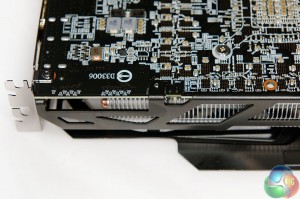
There is no Crossfire connector on the R9 290 WindForce. The 290X and 290 offer Bridgeless Crossfire capabilities. In the picture above you can see a BIOS switch however unlike the 290X, this switch doesn’t change any settings. Those who have read our previous editorials will already be aware that the BIOS switch on the 290X would shift between a 40% and a 55% maximum fan profile.

The card has a DVI-I, DVI-D, full sized HDMI and DisplayPort connectors.
R9 Series graphics cards can now support up to three HDMI/DVI displays for use with AMD Eyefinity technology. A set of displays which support identical timings is required to enable this feature. The display clocks and timing for this feature are configured at boot time.
As such, display hot‐plugging is not supported for the third HDMI/DVI connection. A reboot is required to enable three HDMI/DVI displays.


Above, we can see the Gigabyte R9 290 disassembled. They are using a direct touch cooler, with five thick heatpipes running straight along the full length.

Above, an overview of the Gigabyte R9 290 WindForce OC. The Hawaii CPU is built on the 28nm process and has 64 ROPS, 160 Texture units, and 2,560 Stream processors. The 4GB of GDDR5 memory is connected via a wide 512 bit memory interface. Gigabyte have overclocked the core to 1,040mhz.
On this page we present some super high resolution images of the product taken with the 24.5MP Nikon D3X camera and 24-70mm ED lens. These will take much longer to open due to the dimensions, especially on slower connections. If you use these pictures on another site or publication, please credit Kitguru.net as the owner/source. You can right click and ‘save as’ to your computer to view later.
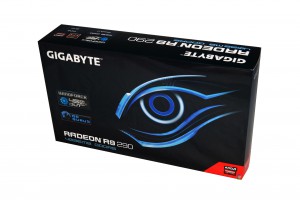
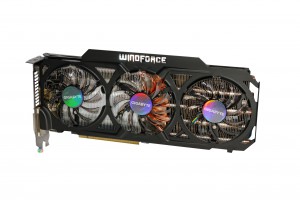







Today we slot the Gigabyte R9 290 WindForce OC into a series of tests we have ran on other cards. We are using the latest AMD Catalyst 13.11 beta driver and the Nvidia ForceWare 334.67 beta driver.

We are using one of our brand new test rigs supplied by PCSPECIALIST and built to our specifications. If you want to read more about this, or are interested in buying the same Kitguru Test Rig, check out our article with links on this page.

We are featuring results today with an Apple 30 inch Cinema HD Display at 2560×1600 resolution and an Asus PQ321QE Ultra HD 4K screen running at 4K 3840 x 2160 resolution.
Room ambient was held at 23c throughout testing.
Comparison cards:
Asus R9 290X Direct CU II OC (1,050mhz / 1,350mhz memory)
Sapphire R9 290X Tri-X OC (1,040mhz core / 1,300mhz memory)
Gigabyte R9 290X OC WindForce (1,040mhz core / 1,250mhz memory)
AMD R9 290X (1000mhz core / 1,250mhz memory)
AMD R9 290 (947mhz core / 1,250mhz memory)
Palit JetStream GTX780 Ti OC (980mhz core / 1,750mhz memory)
Nvidia GTX780 Ti (876mhz core / 1,750mhz memory)
Nvidia GTX Titan (837mhz core / 1,502mhz memory)
Nvidia GTX780 (863mhz core / 1,502mhz memory)
MSI GTX780 Lightning (980mhz core / 1,502mhz memory)
Sapphire R9 290 Tri-X OC Edition (1000mhz / 1300 mhz memory)
Sapphire R9 280X Toxic Edition (1,150mhz core / 1,600mhz memory)
Palit GTX770 OC (1046mhz core / 1753mhz memory)
Software:
Windows 7 Enterprise 64 bit
Unigine Heaven Benchmark
Unigine Valley Benchmark
3DMark Vantage
3DMark 11
3DMark
Fraps Professional
Steam Client
FurMark
Games:
Sleeping Dogs
Total War: Rome 2
Dirt Showdown
Tomb Raider
Metro Last Light
GRID 2
Splinter Cell Blacklist
Batman Arkham Origins
Battlefield 4
All the latest BIOS updates and drivers are used during testing. We perform generally under real world conditions, meaning KitGuru tests games across five closely matched runs and then average out the results to get an accurate median figure. If we use scripted benchmarks, they are mentioned on the relevant page.
Unigine provides an interesting way to test hardware. It can be easily adapted to various projects due to its elaborated software design and flexible toolset.
A lot of their customers claim that they have never seen such extremely-effective code, which is so easy to understand.
Heaven Benchmark is a DirectX 11 GPU benchmark based on advanced Unigine engine from Unigine Corp. It reveals the enchanting magic of floating islands with a tiny village hidden in the cloudy skies. Interactive mode provides emerging experience of exploring the intricate world of steampunk.
Efficient and well-architected framework makes Unigine highly scalable:
- Multiple API (DirectX 9 / DirectX 10 / DirectX 11 / OpenGL) render
- Cross-platform: MS Windows (XP, Vista, Windows 7) / Linux
- Full support of 32bit and 64bit systems
- Multicore CPU support
- Little / big endian support (ready for game consoles)
- Powerful C++ API
- Comprehensive performance profiling system
- Flexible XML-based data structures

We use the settings shown above at 2560×1600.


An average frame rate of 51.3 places the Gigabyte R9 290 WindForce OC at the top of the R9 290 pile.
Valley Benchmark is a new GPU stress-testing tool from the developers of the very popular and highly acclaimed Heaven Benchmark. The forest-covered valley surrounded by vast mountains amazes with its scale from a bird’s-eye view and is extremely detailed down to every leaf and flower petal. This non-synthetic benchmark powered by the state-of-the art UNIGINE Engine showcases a comprehensive set of cutting-edge graphics technologies with a dynamic environment and fully interactive modes available to the end user.

We test with the settings above both at 2560×1600.
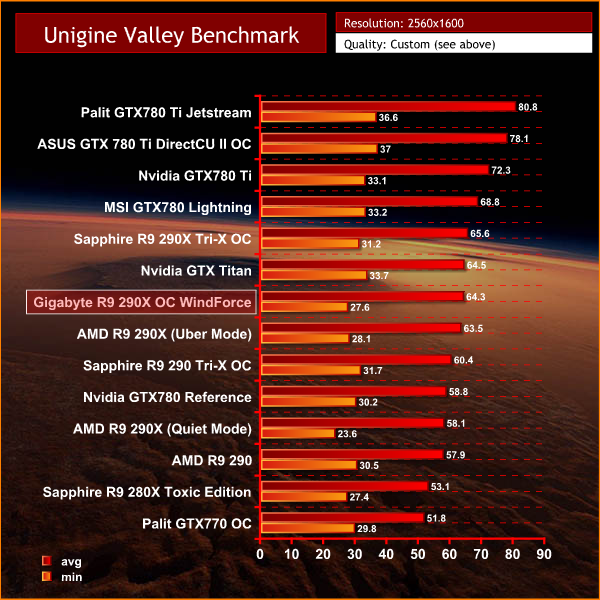

The Gigabyte R9 290 Windforce OC scores just behind the reference AMD R9 290X, only 2 frames slower.
Futuremark released 3DMark Vantage, on April 28, 2008. It is a benchmark based upon DirectX 10, and therefore will only run under Windows Vista (Service Pack 1 is stated as a requirement) and Windows 7. This is the first edition where the feature-restricted, free of charge version could not be used any number of times. 1280×1024 resolution was used with performance settings.


The final score of 46,549 points slots the card in between the reference R9 290X in UBER mode and in QUIET mode. This just goes to show how badly crippled the reference cards are by the weak cooling system.
3DMark 11 is designed for testing DirectX 11 hardware running on Windows 7 and Windows Vista the benchmark includes six all new benchmark tests that make extensive use of all the new features in DirectX 11 including tessellation, compute shaders and multi-threading. After running the tests 3DMark gives your system a score with larger numbers indicating better performance. Trusted by gamers worldwide to give accurate and unbiased results, 3DMark 11 is the best way to test DirectX 11 under game-like loads.


A very strong result, again matching the performance of the reference R9 290X in QUIET mode. The reference cooler on these cards completely struggles to maintain the default thermal curve, so the 290X core is throttling all the time.
3DMark is an essential tool used by millions of gamers, hundreds of hardware review sites and many of the world’s leading manufacturers to measure PC gaming performance.
Futuremark say “Use it to test your PC’s limits and measure the impact of overclocking and tweaking your system. Search our massive results database and see how your PC compares or just admire the graphics and wonder why all PC games don’t look this good.
To get more out of your PC, put 3DMark in your PC.”

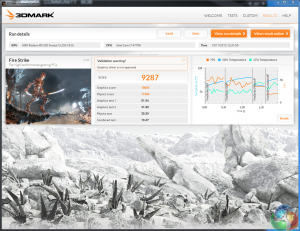
Interesting to see that the Nvidia GTX Titan is slightly outperformed in this benchmark by the overclocked, custom cooled Gigabyte R9 290.
Aliens V Predator has proved to be a big seller since the release and Sega have taken the franchise into new territory after taking it from Sierra. AVP is a Direct X 11 supported title and delivers not only advanced shadow rendering but high quality tessellation for the cards on test today. To test the cards we used a 2560×1600 resolution with DX11, Texture Quality Very High, MSAA Samples 1, 16 af, ambient occlusion on, shadow complexity high, motion blur on.
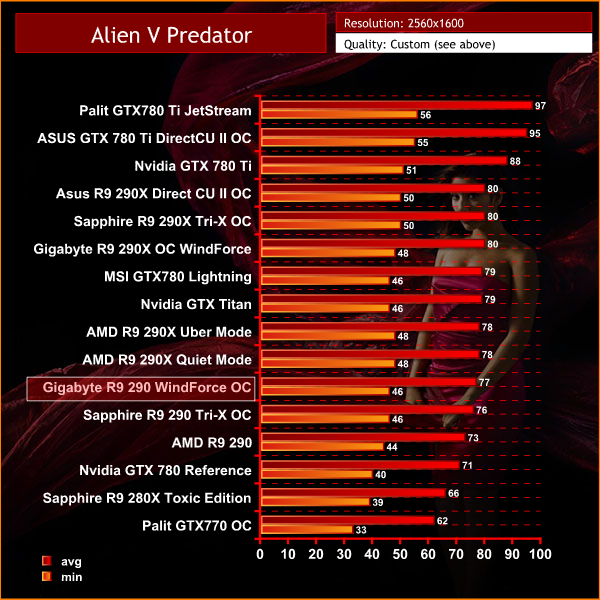
Solid performance and smooth frame rates at all times at 1600p.
Aliens V Predator has proved to be a big seller since the release and Sega have taken the franchise into new territory after taking it from Sierra. AVP is a Direct X 11 supported title and delivers not only advanced shadow rendering but high quality tessellation for the cards on test today.

To test the cards we used a ULTRA HD 4K resolution (3840×2160) with DX11, Texture Quality Very High, MSAA Samples 1, 16 af, ambient occulsion on, shadow complexity high, motion blur on.

To get smooth frame rates at Ultra HD 4k, you really need one of the overclocked R9 290X solutions, such as the Sapphire R9 290X Tri-X OC. The GTX780 Ti however rules this benchmark, with the Palit GTX780 Ti JetStream taking top spot.
Sleeping Dogs started development as an original title, but was announced in 2009 as True Crime: Hong Kong, the third installment and a reboot of the True Crime series.As a result of the game’s high development budget and delays, it was canceled by Activision Blizzard in 2011. Six months later, it was announced that Square Enix had picked up the publishing rights to the game, but the game was renamed Sleeping Dogs in 2012 since Square Enix did not purchase the True Crime name rights.

This game is still a system killer at these maximised settings. We test at 2560×1600.

This is a very demanding engine at these settings, although the overclocked R9 290 manages to maintain a 25+ frame rate at all times.
Sleeping Dogs started development as an original title, but was announced in 2009 as True Crime: Hong Kong, the third installment and a reboot of the True Crime series.As a result of the game’s high development budget and delays, it was canceled by Activision Blizzard in 2011. Six months later, it was announced that Square Enix had picked up the publishing rights to the game, but the game was renamed Sleeping Dogs in 2012 since Square Enix did not purchase the True Crime name rights.


We used the ‘HIGH’ graphics level setting at 4K- 3840×2160. This uses a mixture of high and extreme graphics settings, detailed above.


As we reduced the image quality settings a little, we are still able to maintain smooth frame rates at all times, although if you want 30+ at all times then an overclocked GTX 780 Ti would be the best option.
Total War ROME 2 is the eighth stand alone game in the Total War series, it is the successor to the successful Rome: Total War title. The Warscape Engine powers the visuals of the game and the new unit cameras will allow players to focus on individual soldiers on the battlefield, which in itself may contain thousands of combatants at a time. Creative Assembly has stated that they wish to bring out the more human side of war this way, with soldiers reacting with horror as their comrades get killed around them and officers inspiring their men with heroic speeches before siege towers hit the walls of the enemy city. This will be realised using facial animations for individual units, adding a feel of horror and realism to the battles.


We test with the ULTRA profile at 2560×1600. Details shown in the screenshots above.

Total War ROME 2 runs well on the R9 290 hardware, averaging just below 60 frames per second at these settings.
Total War ROME 2 is the eighth stand alone game in the Total War series, it is the successor to the successful Rome: Total War title. The Warscape Engine powers the visuals of the game and the new unit cameras will allow players to focus on individual soldiers on the battlefield, which in itself may contain thousands of combatants at a time. Creative Assembly has stated that they wish to bring out the more human side of war this way, with soldiers reacting with horror as their comrades get killed around them and officers inspiring their men with heroic speeches before siege towers hit the walls of the enemy city. This will be realised using facial animations for individual units, adding a feel of horror and realism to the battles.


We test at 4K – 3840×2160 with the Very High Preset selected, as shown in the screenshots above.


Even at Ultra HD 4k, the Gigabyte R9 290 WindForce OC is able to hold frame rates above 25 at all times. These engine is extremely demanding at these high image quality settings, especially at this resolution.
Dirt Showdown is the latest title in the franchise from Codemasters, based around the famous Colin McRae racing game series, although it no longer uses his name, since he passed away in 2007.


Today we test the hardware at 2560×1600 with the Ultra profile and 8 x MSAA.

The Gigabyte R9 290 WindForce OC holds the frame rate above 60, almost all the time, dropping once to 58 frames per second.
Dirt Showdown is the latest title in the franchise from Codemasters, based around the famous Colin McRae racing game series, although it no longer uses his name, since he passed away in 2007.


Today we test with the ULTRA profile, at 4K 3840×2160 resolution and with 8 times Anti Aliasing.


Again, a smooth experience holding at 40 frames per second or more throughout the race.
Tomb Raider received much acclaim from critics, who praised the graphics, the gameplay and Camilla Luddington’s performance as Lara with many critics agreeing that the game is a solid and much needed reboot of the franchise. Much criticism went to the addition of the multiplayer which many felt was unnecessary.


We use the ULTIMATE profile shown above and test at 2560×1600.
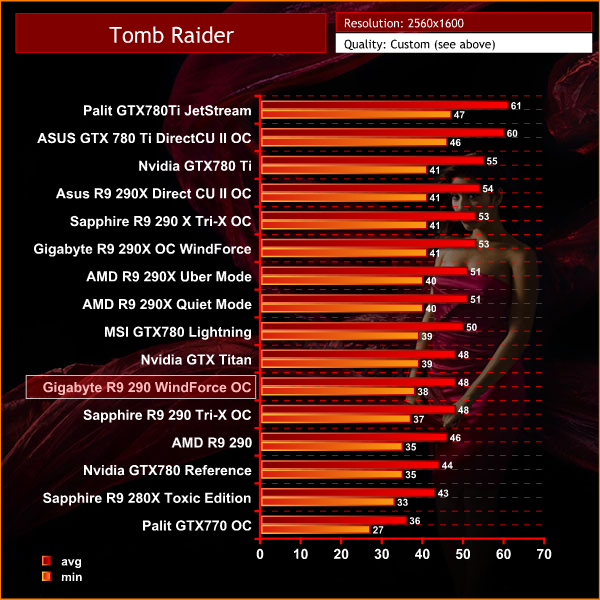
One of my favourite games of the last year, and it looks fantastic on the high end AMD hardware. The Gigabyte R9 290 WindForce OC runs the engine well, averaging almost 50 frames per second.
After a delayed release from late 2012 to March 2013, the game received much anticipation and hype. Tomb Raider received much acclaim from critics, who praised the graphics, the gameplay and Camilla Luddington’s performance as Lara with many critics agreeing that the game is a solid and much needed reboot of the franchise. Much criticism went to the addition of the multiplayer which many felt was unnecessary. Tomb Raider went on to sell one million copies in forty-eight hours of its release, and has sold 3.4 million copies worldwide so far.


We test at 4K 3840×2160 resolution with the ULTRA profile setting enabled – details in the images above.


Superb performance, holding above 30 frames throughout.
Metro: Last Light takes place one year after the events of Metro 2033, proceeding from the ending where Artyom chose to call down the missile strike on the Dark Ones. The Rangers have since occupied the D6 military facility, with Artyom having become an official member of the group. Khan, the nomad mystic, arrives at D6 to inform Artyom and the Rangers that a single Dark One survived the missile strike. 4A Games’ proprietary 4A Engine is capable of rendering breathtaking vistas, such as those showing the ruined remnants of Moscow, as well as immersive indoor areas that play with light and shadow, creating hauntingly beautiful scenes akin to those from modern-day photos of Pripyat’s abandoned factories and schools.

We test this game with the built in benchmark with very high quality settings at 1920×1080 – details shown in the image above.

A demanding benchmark, however the Gigabyte R9 290 WindForce OC scores well, holding around mid table in our high end shootout.
Metro: Last Light takes place one year after the events of Metro 2033, proceeding from the ending where Artyom chose to call down the missile strike on the Dark Ones. The Rangers have since occupied the D6 military facility, with Artyom having become an official member of the group. Khan, the nomad mystic, arrives at D6 to inform Artyom and the Rangers that a single Dark One survived the missile strike. 4A Games’ proprietary 4A Engine is capable of rendering breathtaking vistas, such as those showing the ruined remnants of Moscow, as well as immersive indoor areas that play with light and shadow, creating hauntingly beautiful scenes akin to those from modern-day photos of Pripyat’s abandoned factories and schools.

We test this game with the built in benchmark, with the settings detailed above. Direct X 11 mode, Quality is set at medium, 16 AF, normal Motion blur, Tessellation Normal, Advanced PhysX disabled and SSAA disabled.


Again, a good result, averaging around 50 frames per second.
Grid 2 is the sequel to the racing video game Race Driver: Grid. It was developed and published by Codemasters. The game includes numerous real world locations such as Paris, numerous United States locations, and many more, and also includes motor vehicles spanning four decades. In addition, it includes a new handling system that developer Codemasters has dubbed ‘TrueFeel’, which aims to hit a sweet spot between realism and accessibility.



We test at 2560×1600 with the Ultra image quality preset, as shown above. 8x MSAA was enabled to improve image quality.

Until the GTX780 Ti was released, AMD held the top positions in this chart. That said, the Gigabyte R9 290 WindForce OC scores well in this benchmark, holding an average frame rate around 80.
Grid 2 is the sequel to the racing video game Race Driver: Grid. It was developed and published by Codemasters. The game includes numerous real world locations such as Paris, numerous United States locations, and many more, and also includes motor vehicles spanning four decades. In addition, it includes a new handling system that developer Codemasters has dubbed ‘TrueFeel’, which aims to hit a sweet spot between realism and accessibility.


We select 4K 3840×2160 resolution and enabled the ULTRA profile with 8 times anti aliasing, as shown in the screenshots above.

If you are lucky to have an Ultra HD 4K monitor then you can expect a 40+ frame rate from the Gigabyte R9 290 WindForce OC, at these settings.
Splinter Cell Blacklist is the sixth installment in the series. The game begins with Sam Fisher and his old friend Victor Coste who are about to depart from Andersen AFB in Guam when an unknown enemy force destroys the entire base. Assisted by hacker specialist Charlie Cole, Sam and Vic manage to escape, although Vic is injured after protecting Sam from a grenade. Soon after, a terrorist group calling itself “The Engineers” assumes responsibility for the attack and announce that it was the first of a deadly countdown of escalating attacks (called “The Blacklist”) on United States assets, declaring that they will halt the attacks only after the U.S. government accomplish the demand of calling back all American troops deployed abroad.


We test with a series of high image quality settings as shown above and with 4x MSAA and 16 x Anisotropic filtering enabled.

Again, the overclocked GTX780 Ti's lead this benchmark, outperforming the overclocked R9 290X solutions. The Gigabyte R9 290 WindForce OC scores well however, holding an average frame rate of 60 throughout our test.
Splinter Cell Blacklist is the sixth installment in the series. The game begins with Sam Fisher and his old friend Victor Coste who are about to depart from Andersen AFB in Guam when an unknown enemy force destroys the entire base. Assisted by hacker specialist Charlie Cole, Sam and Vic manage to escape, although Vic is injured after protecting Sam from a grenade. Soon after, a terrorist group calling itself “The Engineers” assumes responsibility for the attack and announce that it was the first of a deadly countdown of escalating attacks (called “The Blacklist”) on United States assets, declaring that they will halt the attacks only after the U.S. government accomplish the demand of calling back all American troops deployed abroad.


We selected 4K – 3840×2160 resolution and the ‘High’ Graphics quality preset. Screenshots shown above.


Splinter Cell Blacklist looks great at Ultra HD 4K, and the Gigabyte R9 290 WindForce OC has enough power to maintain a +35 frame rate throughout the test.
Batman Arkham Origins moved development away from series creators Rocksteady Studios, and is written by Corey May and Dooma Wendschuh. The game’s main storyline is set five years before that of 2009′s Batman: Arkham Asylum and follows a younger and less refined Batman who has a bounty placed on his head by crime lord Black Mask, drawing eight of the world’s greatest assassins to Gotham City on Christmas Eve. The game is presented from the third-person perspective with a primary focus on Batman’s combat and stealth abilities, detective skills, and gadgets that can be used in both combat and exploration. Arkham Origins is the first game in the series to feature multiplayer gameplay.

We test at Ultra HD 4K with a mixture of high image quality settings and 2 MSAA, shown above.


One of the best looking games, designed for Ultra HD 4K resolutions as evidenced by the textures and detail. It is a very taxing engine at these settings however, averaging 38 frames per second, and dropping a couple of times to 27 frames per second.
Battlefield 4 (also known as BF4) is a first-person shooter video game developed by EA Digital Illusions CE (DICE) and published by Electronic Arts. The game is a sequel to 2011′s Battlefield 3. Battlefield 4 is built on the new Frostbite 3 engine. The new Frostbite engine enables more realistic environments with higher resolution textures and particle effects. A new “networked water” system is also being introduced, allowing all players in the game to see the same wave at the same time.Tessellation has also been overhauled.

We test at Ultra HD 4K with the high image quality profile, shown above.


Playable, although some people may want to reduce the image quality settings a little to push the frame rate above 30 at all times.The tests were performed in a controlled air conditioned room with temperatures maintained at a constant 24c – a comfortable environment for the majority of people reading this.Idle temperatures were measured after sitting at the desktop for 30 minutes.Load measurements were acquired by playing Crysis Warhead for 30 minutes and measuring the peak temperature. We also have included Furmark results, recording maximum temperatures throughout a 30 minute stress test. All fan settings were left on automatic.
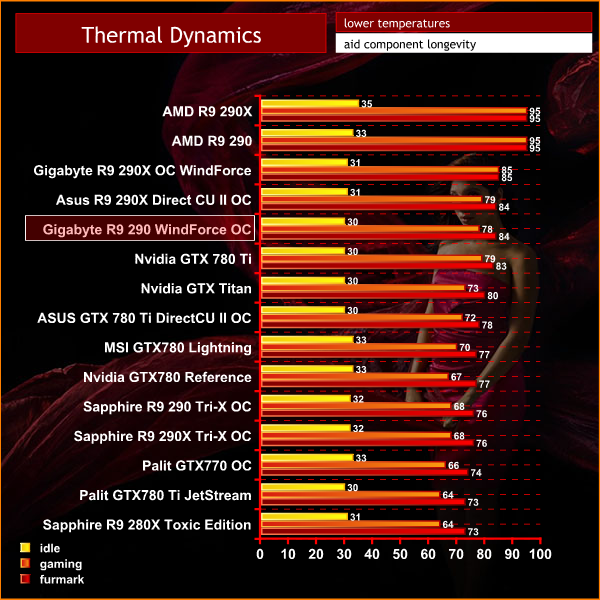
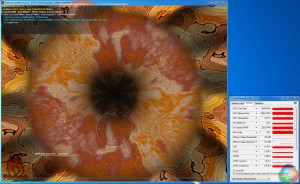
The driver profile for this card is set at 85%, and the card will hover around 78c when gaming – well within the driver profile parameters set out in Catalyst Control Center.
We have built a system inside a Lian Li chassis with no case fans and have used a fanless cooler on our CPU. The motherboard is also passively cooled. This gives us a build with almost completely passive cooling and it means we can measure noise of just the graphics card inside the system when we run looped 3dMark tests.
We measure from a distance of around 1 meter from the closed chassis and 4 foot from the ground to mirror a real world situation. Ambient noise in the room measures close to the limits of our sound meter at 28dBa.
Why do this? Well this means we can eliminate secondary noise pollution in the test room and concentrate on only the video card. It also brings us slightly closer to industry standards, such as DIN 45635.
KitGuru noise guide
10dBA – Normal Breathing/Rustling Leaves
20-25dBA – Whisper
30dBA – High Quality Computer fan
40dBA – A Bubbling Brook, or a Refrigerator
50dBA – Normal Conversation
60dBA – Laughter
70dBA – Vacuum Cleaner or Hairdryer
80dBA – City Traffic or a Garbage Disposal
90dBA – Motorcycle or Lawnmower
100dBA – MP3 player at maximum output
110dBA – Orchestra
120dBA – Front row rock concert/Jet Engine
130dBA – Threshold of Pain
140dBA – Military Jet takeoff/Gunshot (close range)
160dBA – Instant Perforation of eardrum

The Gigabyte R9 290 WindForce OC is another exceptionally quiet card, rating the same (within margin of readout error) as the 290X version of the hardware.
To test power consumption today we are using a Keithley Integra unit and we measure power consumption from the VGA card inputs, not the system wide drain. We measure results while gaming in Crysis Warhead and the synthetic stress test Furmark and record both results.

Power consumption of the hardware falls into the expected zone.
To overclock today, we used the dedicated overclocking tools within the latest version of AMD’s Catalyst Control Center.
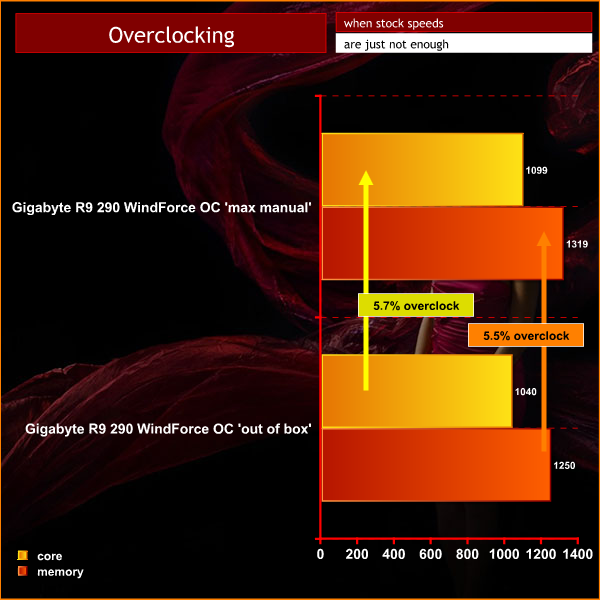

We managed to get the card stable to 1,100mhz, an additional 5.7% core overclock on the ‘out of the box speeds'. Increasing the power limit settings past 30% did not reap any further reward. The GDDR5 memory had a little extra headroom, hitting 1,319mhz before artifacting would occur.
AMD may have dropped the ball with the R9 290/x reference card launch, but fortunately their key partners have been delivering some remarkable custom solutions in the last month.
The Gigabyte R9 290 WindForce OC is a very high performance, low noise graphics card able to power many of the latest Direct X 11 titles at 1600p and Ultra HD 4K resolutions.
Right now, the enthusiast user has several fantastic options to choose from. We rate the Sapphire R9 290 Tri-X OC highly, having reviewed it back on December 19th. This card has clearly been designed with a primary focus on cooling performance. Our test results indicated a staggering 27c improvement on load temperatures -when compared directly to the reference solution.
The Gigabyte R9 290 WindForce OC runs 10c hotter than the Sapphire R9 290 Tri-X OC under load, which in reality is a little disappointing. Gigabyte have optimised the fan profile to run at a thermal curve peak of 85c, with a main focus on reducing noise emissions.
This works well, as the card is very quiet under load … however we would prefer to see a slightly more aggressive default fan profile configuration. Overall, we feel the Tri-X cooler is slightly better than the Gigabyte WindForce offering.
The Gigabyte R9 290 WindForce OC is the fastest ‘out of the box' R9 290 we have tested to date and as such performs slightly better than the Sapphire R9 290 Tri-X OC in most situations. That said, we found the Sapphire card could be manually tweaked to a higher level in Catalyst Control Center, although making such a sweeping ‘global' statement based on only two samples is foolish. Every card will exhibit different overclocking headroom.
You can buy the Gigabyte R9 290 Windforce OC from Overclockers UK for £379.99 inc vat.
Discuss on our Facebook page, over HERE.
Pros:
- default fan settings are optimised for noise.
- well built.
- excellent performance.
- fast core overclock.
Cons:
- ‘WindForce' Cooler doesn't perform to the same level as the ‘Tri-X' OC counterpart on the Sapphire R9 290 model.
Kitguru says: An excellent solution able to power the latest games at 1600p and Ultra HD 4K resolutions.

 KitGuru KitGuru.net – Tech News | Hardware News | Hardware Reviews | IOS | Mobile | Gaming | Graphics Cards
KitGuru KitGuru.net – Tech News | Hardware News | Hardware Reviews | IOS | Mobile | Gaming | Graphics Cards


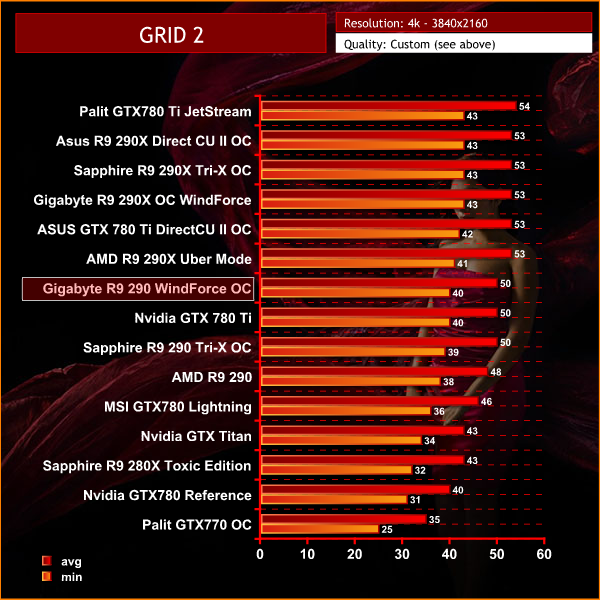
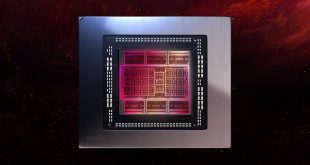
I have the Gigabyte R9 290OC 4G Windforce Ed. And all i can say is… Damn it’s Awesome! It’s awesome in anything! And i don’t regret buying this little monster. Am i gonna give 6 star for this card.